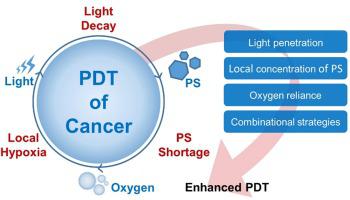当前位置:
X-MOL 学术
›
Prog. Mater. Sci.
›
论文详情
Our official English website, www.x-mol.net, welcomes your feedback! (Note: you will need to create a separate account there.)
Recent advances in photonanomedicines for enhanced cancer photodynamic therapy
Progress in Materials Science ( IF 37.4 ) Pub Date : 2020-10-01 , DOI: 10.1016/j.pmatsci.2020.100685 Jing-Jing Hu , Qi Lei , Xian-Zheng Zhang
Progress in Materials Science ( IF 37.4 ) Pub Date : 2020-10-01 , DOI: 10.1016/j.pmatsci.2020.100685 Jing-Jing Hu , Qi Lei , Xian-Zheng Zhang

|
Abstract Nowadays, photodynamic therapy (PDT) that employs photosensitizers (PSs) to generate cytotoxic species under light irradiation for selective destruction of neoplastic lesions has attracted extensive research attention. Despite the significant progress of PDT, its clinical-translation is still hampered by the insufficiency of three essential elements (light, PSs, and oxygen) at tumor sites. Spurred by the current explosion of nanotechnology, developing photonanomedicines (PNMs) to overcome critical obstacles of conventional PDT has become promising. In this review, we highlight recent research advances in PNMs, which focus on enhanced efficiency of cancer PDT. The design strategies of PNMs are classified into four sections, overcoming the limited light penetration depth, increasing the local PSs concentration, tackling the hypoxic problem, as well as combining with other treatments. Furthermore, the issues and outlook of PNMs for enhanced PDT are also discussed.
中文翻译:

用于增强癌症光动力治疗的光纳米药物的最新进展
摘要 如今,利用光敏剂(PSs)在光照射下产生细胞毒性物质以选择性破坏肿瘤病变的光动力疗法(PDT)引起了广泛的研究关注。尽管 PDT 取得了重大进展,但其临床转化仍受到肿瘤部位三种基本元素(光、PS 和氧)不足的阻碍。在当前纳米技术爆炸式发展的推动下,开发光纳米医学 (PNM) 以克服传统 PDT 的关键障碍已变得很有希望。在这篇综述中,我们重点介绍了 PNM 的最新研究进展,重点是提高癌症 PDT 的效率。PNMs的设计策略分为四个部分,克服有限的透光深度,增加局部PSs浓度,解决缺氧问题,以及与其他治疗相结合。此外,还讨论了用于增强 PDT 的 PNM 的问题和前景。
更新日期:2020-10-01
中文翻译:

用于增强癌症光动力治疗的光纳米药物的最新进展
摘要 如今,利用光敏剂(PSs)在光照射下产生细胞毒性物质以选择性破坏肿瘤病变的光动力疗法(PDT)引起了广泛的研究关注。尽管 PDT 取得了重大进展,但其临床转化仍受到肿瘤部位三种基本元素(光、PS 和氧)不足的阻碍。在当前纳米技术爆炸式发展的推动下,开发光纳米医学 (PNM) 以克服传统 PDT 的关键障碍已变得很有希望。在这篇综述中,我们重点介绍了 PNM 的最新研究进展,重点是提高癌症 PDT 的效率。PNMs的设计策略分为四个部分,克服有限的透光深度,增加局部PSs浓度,解决缺氧问题,以及与其他治疗相结合。此外,还讨论了用于增强 PDT 的 PNM 的问题和前景。



























 京公网安备 11010802027423号
京公网安备 11010802027423号